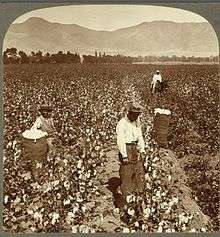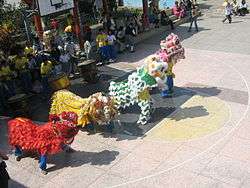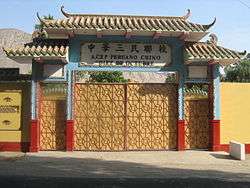Chinese Peruvians
| Total population | |
|---|---|
| est. 1,000,000+[1] | |
| Regions with significant populations | |
| Lima, Huacho, Ica, Piura, Huancayo, Cusco, Moyobamba, Tarapoto, Iquitos. | |
| Languages | |
| Peruvian Spanish, Mandarin, Hakka, Cantonese, Hokkien, others | |
| Religion | |
| Roman Catholicism, Buddhism, Chinese folk religion | |
| Related ethnic groups | |
| Asian Latin Americans, Asian Peruvians |
| Chinese Peruvians | |||||||||||
| Traditional Chinese | 秘魯華僑華人 | ||||||||||
|---|---|---|---|---|---|---|---|---|---|---|---|
| Simplified Chinese | 秘鲁华侨华人 | ||||||||||
| |||||||||||
| Tusán | |||||||||||
| Chinese | 土生 | ||||||||||
| Literal meaning | Local-born | ||||||||||
| |||||||||||
Chinese Peruvians, also known as tusán (a loanword from Chinese: 土生; pinyin: tǔ shēng; Jyutping: tou2 saang1; literally: "local born"), are members of a Peruvian ethnic group whose ancestors came from Guangdong Province in China. They are people of overseas Chinese ancestry born in Peru, or who have made Peru their adopted homeland.
Most Chinese Peruvians are multilingual. In addition to Spanish or Quechua, many of them speak one or more varieties of Chinese that may include Mandarin, Cantonese, Hakka and Minnan (Hokkien). Since the first Chinese immigrants came from Macau, and the southern region of the province, some of them also speak Portuguese.
Outside of the predominant Amerindian, mestizo, and white populations, black, Japanese, Chinese and others are estimated to constitute 3% of the Peruvian population.[2] Other sources estimate that the population of Peruvians with Chinese ancestry is as high as 20% when people of mixed heritage are included in the statistics.
History
Early history
.jpg)

Asian coolies who were shipped from the Spanish Philippines to Acapulco via the Manila-Acapulco galleons were all called Chino ("Chinese"), although in reality they were not only from China but also other places, including what are today the Philippines itself, Japan, Malaysia, Indonesia, East Timor, and further afield such as India and Sri Lanka.[3]:12[4][5][6] Filipinos made up most of their population.[7] The people in this community of diverse Asians in Mexico were called "los indios chinos" by the Spanish.[8] Most of these workers were male and were obtained from Portuguese traders, who obtained them from Portuguese colonial possessions and outposts of the Estado da India, which included parts of India, Bengal, Malacca, Indonesia, Nagasaki in Japan, and Macau.[9][10] Spain received some of these coolies from Mexico, where owning a Chino coolie showed high status.[3]:13 Records of three Japanese coolies dating from the 16th century, named Gaspar Fernandes, Miguel and Ventura who ended up in Mexico showed that they were purchased by Portuguese slave traders in Japan, brought to Manila from where they were shipped to Mexico by their owner Perez.[11][12][13] Some of these Asian slaves were also brought to Lima in Peru, where it was recorded that in 1613 there was a small community of Asians, consisting of Chinese, Japanese, Filipinos, Malays, Cambodians and others.[14][15][16][17]
Chinese immigrants, who in the 19th century took a four-month trip from Macau (then a Portuguese territory), settled as contract laborers or coolies. Other Chinese coolies from Guangdong followed.
One hundred thousand Chinese contract laborers, 95% of which were Cantonese and almost all of which were male, were sent mostly to the sugar plantations from 1849 to 1874, during the termination of slavery. They were to provide continuous labor for the coastal guano mines and especially for the coastal plantations where they became a major labor force (contributing greatly to the Peruvian guano boom) until the end of the century. While the coolies were believed to be reduced to virtual slaves, they also represented a historical transition from slave to free labor. A third group of Chinese workers was contracted for the construction of the railway from Lima to La Oroya and Huancayo. Chinese migrants were barred from using cemeteries reserved for Roman Catholics, and were instead buried at pre-Incan burial sites.[18]

In Peru non-Chinese women married the mostly male Chinese coolies.[19] There were almost no women among the nearly entirely male Chinese coolie population that migrated to Peru and Cuba.[3]:143[20] Peruvian women were married to these Chinese male migrants.[21][22][23][24][25] African women particularly had mostly no intercourse with Chinese men during their labor as coolies, while Chinese had contact with Peruvian women in cities; there they formed relationships and sired mixed babies. These women originated from Andean and coastal areas and did not originally come from the cities; in the haciendas on the coast in rural areas, native young women of indígenas ("native") and serranas ("mountain") origin from the Andes mountains would come down to work. These Andean native women were favored over Africans as marital partners by Chinese men, with matchmakers arranging for communal marriages of Chinese men to young indígenas and serranas.[26] There was a racist reaction by Peruvians to the marriages of Peruvian women and Chinese men.[27] When native Peruvian women (cholas et natives, Indias, indígenas) and Chinese men had mixed children, the children were called injerto; once these injertos emerged, Chinese men sought out girls of injerta origin as marriage partners. Children born to black mothers were not called injertos.[28] Peruvians of low class established sexual unions or marriages with the Chinese men, and some black and Indian women "bred" with the Chinese according to Alfredo Sachettí, who claimed the mixing was causing the Chinese to suffer from "progressive degeneration". In Casa Grande, highland Indian women and Chinese men participated in communal "mass marriages" with each other, arranged when highland women were brought by a Chinese matchmaker after receiving a down payment.[29][30]

In Peru and Cuba, some Indian (Native American), mulatto, black, and white women engaged in carnal relations or marriages with Chinese men, with marriages of mulatto, black, and white woman being reported by the Cuba Commission Report. In Peru, it was reported by The New York Times that Peruvian black and Indian (Native) women married Chinese men to their own advantage and to the disadvantage of the men since they dominated and "subjugated" the Chinese men despite the fact that the labor contract was annulled by the marriage, reversing the roles in marriage with the Peruvian woman holding marital power, ruling the family and making the Chinese men slavish, docile, "servile", "submissive" and "feminine" and commanding them around, reporting that "Now and then...he [the Chinese man] becomes enamored of the charms of some sombre-hued chola (Native Indian and mestiza woman) or samba (mixed black woman), and is converted and joins the Church, so that may enter the bonds of wedlock with the dusky señorita."[31] Chinese men were sought out as husbands and considered a "catch" by the "dusky damsels" (Peruvian women) because they were viewed as a "model husband, hard-working, affectionate, faithful and obedient" and "handy to have in the house", the Peruvian women became the "better half" instead of the "weaker vessel" and would command their Chinese husbands "around in fine style" instead of treating them equally, while the labor contract of the Chinese coolie would be nullified by the marriage, the Peruvian wife viewed the nullification merely as the previous "master" handing over authority over the Chinese man to her as she became his "mistress", keeping him in "servitude" to her, speedily ending any complaints and suppositions by the Chinese men that they would have any power in the marriage.[32]
Another group of Chinese settlers came after the founding of Sun Yat-sen's republic in 1912, and another after the establishment of Communist rule in 1949.
In 1957, Cantonese speakers constituted 85 per cent of the total Chinese immigrant population, the rest of whom were Hakka speakers.[33]
Modern-day immigration
Recent Chinese immigrants settled in Peru from Hong Kong and Macau in 1997 and 1999, owing to fear of those territories returning to Communist rule, while others have come from other places in mainland China, Taiwan, and southeast Asian Chinese communities, including those of Malaysia, Indonesia, Singapore and the Philippines. Many Chinese Indonesians came to Peru after anti-Chinese riots and massacres in those countries in the 1960s, 1970s, and late 1990s. These recent Chinese immigrants make Peru currently the home of the largest ethnically Chinese community in Latin America.
Emigration
Many Chinese Peruvians left Peru in the 1960s and 1970s. Most of them headed to the United States, where they were called Chinese Americans or Peruvian Americans of Chinese descent, while others went to Canada, Spain, mainland China, Hong Kong, Macau, Taiwan, Australia, or New Zealand.
Role in the economy
After their contracts ended, many of them adopted the last name of their patrons (one of the reasons that many Chinese Peruvians carry Spanish last names). Some freed coolies (and later immigrants) established many small businesses. These included chifas (Chinese-Peruvian restaurants - the word is derived from Cantonese 吃飯 (Jyutping:ci3 faan6) which means "to eat rice or to have a meal"). Calle Capón, Lima's Chinatown, also known as Barrio Chino de Lima, became one of the Western Hemisphere's earliest Chinatowns. The Chinese coolies married Peruvian women, and many Chinese Peruvians today are of mixed Chinese, Spanish, African or Native American descent. Chinese Peruvians also assisted in the building of railroad and development of the Amazon Rainforest, where they tapped rubber trees, washed gold, cultivated rice, and traded with the natives. They even became the largest foreign colony in the Amazon capital of Iquitos by the end of the century.
Notable people
Politics
- Víctor Joy Way, former Prime Minister of Peru
- José Antonio Chang, former Prime Minister of Peru
Academic
- Pedro Zulen (1889–1925), philosopher, university professor (Universidad Nacional Mayor de San Marcos), poet, writer[34]
Sports
- Edwin Vasquez Cam, Olympic gold medal Free Pistol (1948)
See also
References
- ↑ "Chinatown in Peru? A Brief Look of the Chinese Diaspora in Latin America". www.panoramas.pitt.edu. Retrieved Oct 8, 2017.
- ↑ "The World Factbook: Peru: People and society". www.cia.gov. Retrieved 31 August 2017.
- 1 2 3 Walton Look Lai; Chee Beng Tan, eds. (2010). The Chinese in Latin America and the Caribbean. BRILL. ISBN 90-04-18213-6. Retrieved 8 January 2016.
- ↑ María Herrera-Sobek, ed. (2012). Celebrating Latino Folklore: An Encyclopedia of Cultural Traditions. 1. ABC-CLIO. p. 59. ISBN 978-0-313-34339-1. Retrieved 8 January 2016.
- ↑ Wolfgang Binder, ed. (1993). Slavery in the Americas. 4. Königshausen & Neumann. p. 100. ISBN 978-3-88479-713-6. Retrieved 8 January 2016.
- ↑ Arnold J. Meagher (2008). The Coolie Trade: The Traffic in Chinese Laborers to Latin America 1847-1874. Arnold J Meagher. p. 194. ISBN 978-1-4363-0943-1. Retrieved 8 January 2016.
- ↑ James W. Russell (2009). Class and Race Formation in North America. University of Toronto Press. p. 27. ISBN 978-0-8020-9678-4. Retrieved 8 January 2016.
- ↑ Machuca Chávez, Claudia Paulina (Autumn–Winter 2009). "El alcalde de los chinos en la provincia de Colima durante el siglo xvii: un sistema de representación en torno a un oficio" [The mayor of the Chinese in the province of Colima during the seventeenth century: a system of representation surrounding trade] (PDF). Letras Históricas (in Spanish). Ciesas Occidente (1): 95–116. Archived from the original (PDF) on 7 April 2014.
- ↑ Oropeza Keresey, Déborah (July–September 2011). "La Esclavitud Asiática en El Virreinato de La Nueva España, 1565-1673" [Asian Slavery in the Viceroyalty of New Spain, 1565-1673] (PDF). Historia Mexicana (in Spanish). El Colegio de México. LXI (1): 20–21. ISSN 0185-0172. Retrieved 31 August 2017.
- ↑ Oropeza, Déborah (Fall–Winter 2009). "Ideas centrales en torno a la esclavitud asiática en la Nueva España" [Central ideas surrounding Asian slavery in New Spain] (PDF). Historia Mexicana (in Spanish). Encuentro de Mexicanistas 2010 (La esclavitud asiática en el virreinato de la Nueva España, 1565-1673) (1): 2. Archived from the original (PDF) on 7 April 2014.
- ↑ "Japanese slaves taken to Mexico in 16th century". Yomiuri Shimbun. 14 May 2013. Archived from the original on 22 October 2016. Retrieved 8 January 2016 – via Asiaone News.
- ↑ Torres, Ida (14 May 2013). "Records show Japanese slaves crossed the Pacific to Mexico in 16th century". Japan Daily Press. Archived from the original on 31 January 2016. Retrieved 8 January 2016.
- ↑ Preston Phro (15 May 2013). "To Mexico in Chains: The Tale of Three 16th Century Japanese Slaves". Rocket News 24. Retrieved 8 January 2016.
- ↑ Leslie Bethell, ed. (1984). The Cambridge History of Latin America. Colonial Latin America. II. Cambridge University Press. p. 21. ISBN 978-0-521-24516-6. Retrieved 8 January 2016.
- ↑ Ignacio López-Calvo (2013). The Affinity of the Eye: Writing Nikkei in Peru. University of Arizona Press. p. 134. ISBN 978-0-8165-9987-5. Retrieved 8 January 2016.
- ↑ Dirk Hoerder (2002). Cultures in Contact: World Migrations in the Second Millennium. Duke University Press. p. 200. ISBN 0-8223-8407-8. Retrieved 8 January 2016.
- ↑ Fernando Iwasaki Cauti (2005). Extremo Oriente y el Perú en el siglo XVI. Fondo Editorial PUCP. p. 293. ISBN 978-9972-42-671-1. Retrieved 8 January 2016.
- ↑ "Peru discovers in pre-Incan site tomb of 16 Chinese migrants". Phys.org. August 24, 2017.
The Chinese were discriminated against even in death, having to be buried in the pre-Incan sites after being barred from cemeteries reserved for Roman Catholics.
- ↑ Meade, Teresa A. (2011). A History of Modern Latin America: 1800 to the Present. John Wiley & Sons. p. 148. ISBN 978-1-4443-5811-7. Retrieved 1 September 2017.
- ↑ Adam McKeown (2001). Chinese Migrant Networks and Cultural Change: Peru, Chicago, and Hawaii 1900-1936. University of Chicago Press. p. 47. ISBN 978-0-226-56025-0. Retrieved 8 January 2016.
- ↑ Robert G. Lee (1999). Orientals: Asian Americans in Popular Culture. Temple University Press. p. 75. ISBN 1439905711. Retrieved May 17, 2014.
- ↑ Chee-Beng Tan (2004). Chinese Overseas: Comparative Cultural Issues. Hong Kong University Press. p. 47. ISBN 978-962-209-661-5. Retrieved 8 January 2016.
- ↑ Josephine D. Lee; Imogene L. Lim; Yuko Matsukawa. Re/collecting Early Asian America: Essays in Cultural History. Temple University Press. pp. 181–. ISBN 978-1-4399-0120-5.
- ↑ Walton Look Lai (1998). The Chinese in the West Indies, 1806-1995: A Documentary History. University of the West Indies Press. p. 8. ISBN 978-976-640-021-7. Retrieved 8 January 2016.
- ↑ Michael J. Gonzales (2014). Plantation Agriculture and Social Control in Northern Peru, 1875–1933. University of Texas Press. p. 139. ISBN 978-1-4773-0602-4. Retrieved 8 January 2016.
- ↑ Isabelle Lausent-Herrera (2010). Walton Look Lai; Chee Beng Tan, eds. The Chinese in Latin America and the Caribbean. Brill ebook titles. BRILL. p. 144. ISBN 9004182136. Retrieved May 17, 2014.
- ↑ Isabelle Lausent-Herrera (2010). Walton Look Lai; Chee Beng Tan, eds. The Chinese in Latin America and the Caribbean. Brill ebook titles. BRILL. p. 145. ISBN 9004182136. Retrieved May 17, 2014.
- ↑ Isabelle Lausent-Herrera (2010). Walton Look Lai; Chee Beng Tan, eds. The Chinese in Latin America and the Caribbean. Brill ebook titles. BRILL. p. 146. ISBN 9004182136. Retrieved May 17, 2014.
- ↑ Michael J. Gonzales (2014). Plantation Agriculture and Social Control in Northern Peru, 1875–1933. University of Texas Press. ISBN 1477306021. Retrieved May 17, 2014.
- ↑ Michael J. Gonzales (1985). Plantation Agriculture and Social Control in Northern Peru, 1875-1933. Brill ebook titles. Volume 62 of Texas Pan American Series. University of Texas Press. p. 100. ISBN 029276491X. Retrieved May 17, 2014.
- ↑ Elliott Young (2014). Alien Nation: Chinese Migration in the Americas from the Coolie Era Through World War II. David J. Weber Series in the New Borderlands History. 4: Wiley Blackwell Concise History of the Modern World. UNC Press Books. p. 82. ISBN 978-1-4696-1296-6. Retrieved 8 January 2016.
- ↑ "The Coolie Trade: The slavery of the present - The traffic of Peru - Hiring of the Coolie - Horrors of the middle passage the Coolie's fate". New York Times. 28 June 1873. Archived from the original (PDF) on 1 July 2015. Retrieved 17 May 2014.
- ↑ "The Chinese in Peru". Chʻiao. 3, Issue 2. Basement Workshop, Incorporated. 1974. p. 35.
...but in 1957 speakers of Cantonese constituted 85 per cent of the total, the rest of whom were Hakka speakers.
- ↑ "Pedro Zulen: San Marcos u su Tiempo". UNMSM.edu.pe. Archived from the original on September 27, 2011.
Further reading
- De Trazegnies Granda, Fernando (1994), En el país de las colinas de arena: reflexiones sobre la inmigración china en el Perú del S. XIX desde la perspectiva del derecho, Lima: Pontificia Universidad Católica del Perú, ISBN 978-84-89309-82-1, OCLC 31349975
- López-Calvo, Ignacio, Dragons in the Land of the Condor: Writing Tusán in Peru (University of Arizona Press, 2014)
- López-Calvo, Ignacio (Spring 2008), Hu-deHart, Evelyn; López, Kathy, eds., "Sino-Peruvian identity and community as prison: Siu Kam Wen's rendering of self-exploitation and other survival strategies", Afro-Hispanic Review, 27 (1): 73–90
- Lausent-Herrera, Isabelle. "The Chinese in Peru and the Changing Peruvian Chinese Community(ies)." In Journal of Chinese Overseas, 7(2011), pp. 69–113. Available online.
External links
- APCH.com, Asociación Peruano China (official website)
- Newworlder.com, Origins: Lomo Saltado